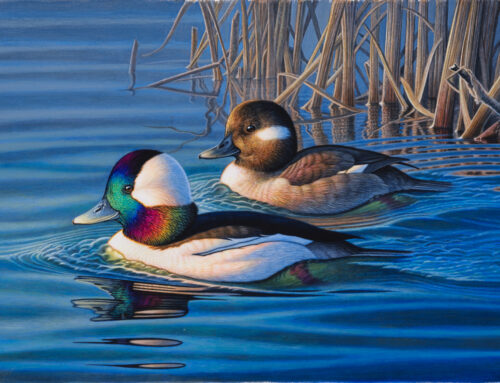Goose Seasons Stacking Up Nicely

Goose hunters should have a decent season ahead, based on population data found in the U.S. Fish and Wildlife Service’s 2019 Waterfowl Population Status Report.
It should be a very good year to be a Washington, Oregon or California goose hunter. Spring populations of most western Canada goose species, as well as western-nesting populations of lesser snow geese were up significantly.
 Spring counts also hint that Central and Mississippi Flyway goose hunters should see a season on par with last year’s, while the Atlantic Flyway will likely see small increases in Canada geese, but reduced flocks of light geese and brant.
Spring counts also hint that Central and Mississippi Flyway goose hunters should see a season on par with last year’s, while the Atlantic Flyway will likely see small increases in Canada geese, but reduced flocks of light geese and brant.
Pacific Flyway
West Coast waterfowlers primarily harvest Canada geese from the Pacific and cackling goose populations. The numbers of the core species remain mostly unchanged in 2019. However, four subspecies posted double-digit percentage gains. Dusky were up 52 percent, Taverner’s up 32 percent, Aleutians 16 percent, and lessers were up 550 percent, although this percentage is skewed by a small sample size.
Counts of Pacific Flyway Population light geese and Wrangel Island snow geese are also up, representing the only really good news for light goose hunters in this year’s survey. Ross’s goose numbers are down by 25 percent this year, and show a 10-year downward trend of 6 percent per year.
Pacific and Central flyway goose hunters love white-fronted geese — often simply called “specks,” short for specklebellies. Mid-content populations are the same as 2018 this year, and the 10-year trend up 4 percent a year. In contrast, Pacific specks nose-dived by more than 100,000 birds, marking a 19 percent decrease.
 Central Flyway
Central Flyway
The Central Flyway’s Western Prairie and Great Plains Canada goose counts were up by 7 percent, but the High-Line (down 8 percent) and Rocky Mountain (down 30 percent) Canada goose populations that primarily feed the western reaches of the Central Flyway did not fare as well.
Snow goose chasers hoping for improved hunting in 2019-2020 might be disheartened again. Many hunters reported difficult hunting in both fall and spring seasons with few to no juveniles in the flock. Chances are the seasons ahead won’t be much improved, as the spring Mid-continent population of snow geese actually declined 9 percent from 2018.
“Spring population counts are fairly reliable when it comes to geese because survival numbers are usually very good — more so than ducks,” explained Dr. Frank Rohwer, president of Delta Waterfowl. “Of course, the number of juvenile birds in the flock come hunting season, which are the easier ones to decoy, has a lot more to do with hatching success and recruitment.”
Estimated breeding pairs of Mid-continent lesser snows peaked at nearly 20 million about 10 years ago, and have declined to less than 12.5 million in recent counts. Specific to the 2019-2020 hunting season, Dr. Ray Alisauskas with the Science & Technology Branch of Environment and Climate Change Canada, reports recent banding captures show there will likely be less than 10 percent juveniles in the flock again. Combined with lower numbers overall, that could mean tough hunting is ahead.
From Baffin Island, a primary nesting area for Mid-content light geese, Dr. Jim LeaFloor of Environment Canada reports, “Based on what I saw, I would say that white geese had average production at best. White goose production was not as good as seen in 2017, but definitely better than last year.”
Mississippi Flyway
In the Upper Midwest, where the harvest is focused heavily on locally reared Canada geese, particularly during early seasons, it appears to be a mixed bag. Wisconsin reported a spring count of Canada geese at 171,407, a 9 percent increase, and 71 percent above the long-term average.
Yet right next door, Minnesota reported historically low breeding Canada goose numbers in May. The population estimate was 110,410, which is down 32 percent and 28 percent below the long-term average. Although a wet spring put Minnesota’s wetlands in excellent condition, a late blizzard may have contributed to the decline.
While resident Canada geese make up as much as 60 percent of the harvest in northern Mississippi and Central flyway states, the other 40 percent comes primarily from four populations: Southern Hudson Bay, Mississippi Flyway Giant, Western Prairie and Great Plains, and Central Flyway Arctic Nesting. Those population estimates range from up 7 percent to down 4 percent. All in, this means these areas should see fall flight numbers similar to 2018.
“Cacklers had an excellent production year on Baffin Island, with a high proportion of goslings in the brood flocks,” LeaFloor reported.
Atlantic Flyway
The North Atlantic Canada goose count was down 3 percent, the Atlantic count up 6 percent, and the Atlantic Flyway resident count was unchanged.
“Atlantic Flyway goose numbers were a bit of a disappointment,” Rohwer said. “We were hoping for some good increases in the Atlantic Flyway migrant population that breeds in the eastern arctic, but counts were up by only a few percentage points. That’s tough on those guys who live for Canada geese on the East Coast.”
Atlantic counts of greater snow geese were also down by 163,000 birds, or 19 percent. And Atlantic brant decreased 29 percent.
“We saw and caught relatively few brant — just 260 adults and 102 goslings,” LeaFloor said. “A large number of the adults were caught in a single flock without goslings, and virtually all females had brood patches. That means they nested, but a lot of nesting females had no young. Brant production will be better than last year, but not great overall.” — Bill Miller





When the population is down I don’t mind a one bird limit in MD but I do mind that PA and NY remain their same limit. Let’s get real, NY gets 2 hits at the going and coming and in mild years they have them there most of the season with much higher limits than MD. Let’s look at the whole picture and limit the whole flyway.